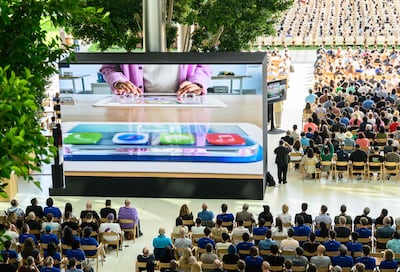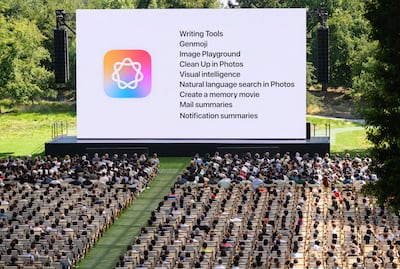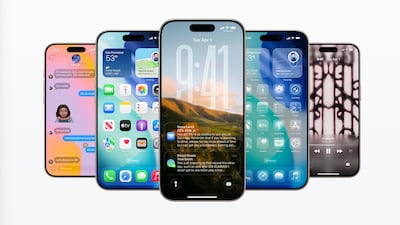Apple on Monday unveiled a new operating system interface called Liquid Glass that will be coming to iPhones, iPads and other devices this autumn.
Apple designers at the Worldwide Developers Conference in Apple Park, California, said the design of iOS 26 will “refract light” and “dynamically respond to touch”, creating a more lively experience.
Liquid Glass's “unified design language” will change how hundreds of millions of iPhone users interact with their devices. It also plays to Apple's strengths, going back to the original Macintosh introduced in 1984, with interfaces that, in theory, make things easier for users.
Apple said Liquid Glass is the most significant iOS redesign since iOS 7.
“Our new design blurs the lines between hardware and software to create an experience that's more delightful than ever. While still familiar and easy to use,” said Alan Dye, Apple vice president of human interfaces.
Through the new interface, Apple said there will be more lock-screen and home-screen personalisation options, and camera app settings will be simpler.
As the conference opened, Apple addressed its failure to deliver an improved Siri voice assistant, which was promised at last year's WWDC.
“This work needed more time to reach our high quality bar, and we look forward to sharing more about it later in the year,” said Craig Federighi, Apple's senior vice president of software engineering.
As was widely speculated before the conference, Apple said it would be changing how it numbers its iOS updates.
The names will correspond to the years in which they are released, meaning the next version due to be released this year will be iOS 26.
Apple also promoted changes to its messaging app, providing more options for personalising group chats.
Background pictures can be picked and assigned to various group chats, polls can be generated in the conversation when appropriate, and there will be enhancements that allow the Apple Cash transfer app to be used within the groups.
The company also enhancing its Genmoji offerings, bringing more emoji customisation features for users.
Live Translation
The company also introduced Live Translation, which will be integrated into the iPhone's Messages, Phone and FaceTime video conferencing iOS apps on the release of iOS 26.
With the help of Apple Intelligence, it allows for conversations to be translated in real time.
According to Apple, Live Translation in Messages will be available in Chinese (Simplified), English, French, German, Italian, Japanese, Korean, Portuguese and Spanish.
Live Translation in Phone and FaceTime will be available in Chinese, English, French, German, Portuguese and Spanish.
Apple demonstrated Live Translation for FaceTime, showing someone speaking in one language with a live caption of the translation presented on screen.
Apple said it would also allow for developers to implement Live Translation into their apps through a new API.
The Live Translation offering is expected to be available when iOS 26 is released.
Apple Intelligence
At its previous WWDC, Apple introduced its generative AI service, Apple Intelligence,
Some of the company's promoted AI features at the time – particularly the writing and image-generation tools, and the optional implementation of integration of OpenAI's ChatGPT – came to fruition, but the much-promised overhaul of Siri, its voice-based digital assistant, was plagued with problems, causing Apple to delay a much-needed update.
Apple hinted at small improvements to Siri, but the larger overhaul would take more time. Mr Federighi announced that the company would be opening up access to the Apple Intelligence generative AI models to outside developers.
“Large language model at the core of Apple intelligence with a new foundation models framework, this gives developers direct access to intelligence that's powerful, fast, built with privacy and available even when you're offline,” he said.
iPad OS window system
Apple also confirmed a long-rumoured overhaul to the iPad's interface, giving users the choice to make it more like a desktop or laptop Mac OS experience, with overlapping and movable windows.
The iPad OS also gives users the option to choose tiled window options that cleanly show the different apps and files open on an iPad in an automatically spaced-out format. The iPad is also getting a menu bar that appears near the top of the screen.
“It's a massive update to the way you work on multiple apps at once,” Mr Ferdaghi said.
Apple emphasised that users can continue to use iPads without the window interface as well.
Apple's WWDC style, compared with Google
Inevitably, expectations were high for Apple, which many felt was put on the defensive by Google's I/O conference several weeks ago when the search-giant did live demonstrations of the company's new AI tools.
Apple's WWDC was recorded and shown on screens to the hundreds of thousands of developers who went to Cupertino for the week-long event.
Although he appeared in the first several minutes of Apple's WWDC, chief executive Tim Cook largely deferred Mr Federighi and other Apple executives to display the company's coming offerings.
The WWDC focused on design and user-interface options, while Google focused on AI integration across its tools, including Gmail and Google Docs.
It is likely that Apple did not satisfy critics who have long complained that it has not been able to deliver a cohesive corporate vision for its AI offerings.
However, it is also clear that Apple is playing for an audience that has not necessarily indicated it wants so much AI technology in smartphones, but cares more about how smartphones make us feel when we use them, in large part because of the design.
TEAMS
US Team
Dustin Johnson, Jordan Spieth
Justin Thomas, Daniel Berger
Brooks Koepka, Rickie Fowler
Kevin Kisner, Patrick Reed
Matt Kuchar, Kevin Chappell
Charley Hoffman*, Phil Mickelson*
International Team
Hideki Matsuyama, Jason Day
Adam Scott, Louis Oosthuizen
Marc Leishman, Charl Schwartzel
Branden Grace, Si Woo Kim
Jhonattan Vegas, Adam Hadwin
Emiliano Grillo*, Anirban Lahiri*
* denotes captain's picks
UAE currency: the story behind the money in your pockets
Timeline
2012-2015
The company offers payments/bribes to win key contracts in the Middle East
May 2017
The UK SFO officially opens investigation into Petrofac’s use of agents, corruption, and potential bribery to secure contracts
September 2021
Petrofac pleads guilty to seven counts of failing to prevent bribery under the UK Bribery Act
October 2021
Court fines Petrofac £77 million for bribery. Former executive receives a two-year suspended sentence
December 2024
Petrofac enters into comprehensive restructuring to strengthen the financial position of the group
May 2025
The High Court of England and Wales approves the company’s restructuring plan
July 2025
The Court of Appeal issues a judgment challenging parts of the restructuring plan
August 2025
Petrofac issues a business update to execute the restructuring and confirms it will appeal the Court of Appeal decision
October 2025
Petrofac loses a major TenneT offshore wind contract worth €13 billion. Holding company files for administration in the UK. Petrofac delisted from the London Stock Exchange
November 2025
180 Petrofac employees laid off in the UAE
The President's Cake
Director: Hasan Hadi
Starring: Baneen Ahmad Nayyef, Waheed Thabet Khreibat, Sajad Mohamad Qasem
Rating: 4/5
((Disclaimer))
The Liechtensteinische Landesbank AG (“Bank”) assumes no liability or guarantee for the accuracy, balance, or completeness of the information in this publication. The content may change at any time due to given circumstances, and the Liechtensteinische Landesbank AG is under no obligation to update information once it has been published. This publication is intended for information purposes only and does not constitute an offer, a recommendation or an invitation by, or on behalf of, Liechtensteinische Landesbank (DIFC Branch), Liechtensteinische Landesbank AG, or any of its group affiliates to make any investments or obtain services. This publication has not been reviewed, disapproved or approved by the United Arab Emirates (“UAE”) Central Bank, Dubai Financial Services Authority (“DFSA”) or any other relevant licensing authorities in the UAE. It may not be relied upon by or distributed to retail clients. Liechtensteinische Landesbank (DIFC Branch) is regulated by the DFSA and this advertorial is intended for Professional Clients (as defined by the DFSA) who have sufficient financial experience and understanding of financial markets, products or transactions and any associated risks.
Specs
Engine: Dual-motor all-wheel-drive electric
Range: Up to 610km
Power: 905hp
Torque: 985Nm
Price: From Dh439,000
Available: Now
Groom and Two Brides
Director: Elie Semaan
Starring: Abdullah Boushehri, Laila Abdallah, Lulwa Almulla
Rating: 3/5
HOW TO WATCH
Facebook: TheNationalNews
Twitter: @thenationalnews
Instagram: @thenationalnews.com
TikTok: @thenationalnews
Everybody%20Loves%20Touda
%3Cp%3E%3Cstrong%3EDirector%3A%3C%2Fstrong%3E%20Nabil%20Ayouch%C2%A0%3C%2Fp%3E%0A%3Cp%3E%3Cstrong%3EStarring%3A%3C%2Fstrong%3E%20Nisrin%20Erradi%2C%20Joud%20Chamihy%2C%20Jalila%20Talemsi%3C%2Fp%3E%0A%3Cp%3E%3Cstrong%3ERating%3A%20%3C%2Fstrong%3E4%2F5%3C%2Fp%3E%0A
MATCH RESULT
Liverpool 4 Brighton and Hove Albion 0
Liverpool: Salah (26'), Lovren (40'), Solanke (53'), Robertson (85')
The biog
Name: Gul Raziq
From: Charsadda, Pakistan
Family: Wife and six children
Favourite holes at Al Ghazal: 15 and 8
Golf Handicap: 6
Childhood sport: cricket
RACE CARD
6.30pm Al Maktoum Challenge Round-1 Group 1 (PA) Dh119,373 (Dirt) 1,600m
7.05pm Handicap (TB) Dh102,500 (D) 1,200m
7.40pm Handicap (TB) Dh105,000 (Turf) 1,800m
8.15pm UAE 1000 Guineas Trial (TB) Dh183,650 (D) 1,400m
9.50pm Handicap (TB) Dh105,000 (D) 1,600m
9.25pm Handicap (TB) Dh95,000 (T) 1,000m
UAE currency: the story behind the money in your pockets
The%20specs
%3Cp%3E%3Cstrong%3EEngine%3A%3C%2Fstrong%3E%202-litre%204-cylinder%3Cbr%3E%3Cstrong%3EPower%3A%20%3C%2Fstrong%3E153hp%20at%206%2C000rpm%3Cbr%3E%3Cstrong%3ETorque%3A%20%3C%2Fstrong%3E200Nm%20at%204%2C000rpm%3Cbr%3E%3Cstrong%3ETransmission%3A%20%3C%2Fstrong%3E6-speed%20auto%3Cbr%3E%3Cstrong%3EFuel%20consumption%3A%20%3C%2Fstrong%3E6.3L%2F100km%3Cbr%3E%3Cstrong%3EPrice%3A%20%3C%2Fstrong%3EDh106%2C900%3Cbr%3E%3Cstrong%3EOn%20sale%3A%20%3C%2Fstrong%3Enow%3C%2Fp%3E%0A
WHY%20AAYAN%20IS%20'PERFECT%20EXAMPLE'
%3Cp%3EDavid%20White%20might%20be%20new%20to%20the%20country%2C%20but%20he%20has%20clearly%20already%20built%20up%20an%20affinity%20with%20the%20place.%3Cbr%3E%3Cbr%3EAfter%20the%20UAE%20shocked%20Pakistan%20in%20the%20semi-final%20of%20the%20Under%2019%20Asia%20Cup%20last%20month%2C%20White%20was%20hugged%20on%20the%20field%20by%20Aayan%20Khan%2C%20the%20team%E2%80%99s%20captain.%3Cbr%3E%3Cbr%3EWhite%20suggests%20that%20was%20more%20a%20sign%20of%20Aayan%E2%80%99s%20amiability%20than%20anything%20else.%20But%20he%20believes%20the%20young%20all-rounder%2C%20who%20was%20part%20of%20the%20winning%20Gulf%20Giants%20team%20last%20year%2C%20is%20just%20the%20sort%20of%20player%20the%20country%20should%20be%20seeking%20to%20produce%20via%20the%20ILT20.%3Cbr%3E%3Cbr%3E%E2%80%9CHe%20is%20a%20delightful%20young%20man%2C%E2%80%9D%20White%20said.%20%E2%80%9CHe%20played%20in%20the%20competition%20last%20year%20at%2017%2C%20and%20look%20at%20his%20development%20from%20there%20till%20now%2C%20and%20where%20he%20is%20representing%20the%20UAE.%3Cbr%3E%3Cbr%3E%E2%80%9CHe%20was%20influential%20in%20the%20U19%20team%20which%20beat%20Pakistan.%20He%20is%20the%20perfect%20example%20of%20what%20we%20are%20all%20trying%20to%20achieve%20here.%3Cbr%3E%3Cbr%3E%E2%80%9CIt%20is%20about%20the%20development%20of%20players%20who%20are%20going%20to%20represent%20the%20UAE%20and%20go%20on%20to%20help%20make%20UAE%20a%20force%20in%20world%20cricket.%E2%80%9D%C2%A0%3C%2Fp%3E%0A
Jewel of the Expo 2020
252 projectors installed on Al Wasl dome
13.6km of steel used in the structure that makes it equal in length to 16 Burj Khalifas
550 tonnes of moulded steel were raised last year to cap the dome
724,000 cubic metres is the space it encloses
Stands taller than the leaning tower of Pisa
Steel trellis dome is one of the largest single structures on site
The size of 16 tennis courts and weighs as much as 500 elephants
Al Wasl means connection in Arabic
World’s largest 360-degree projection surface
Volvo ES90 Specs
Engine: Electric single motor (96kW), twin motor (106kW) and twin motor performance (106kW)
Power: 333hp, 449hp, 680hp
Torque: 480Nm, 670Nm, 870Nm
On sale: Later in 2025 or early 2026, depending on region
Price: Exact regional pricing TBA
STAGE%201%20RESULTS
%3Cp%3E1)%20Tim%20Merlier%20(Soudal-Quick-Step)%2C%203h%2017%E2%80%99%2035%E2%80%9D%3Cbr%3E2)%20Caleb%20Ewan%20(Lotto%20Dstny)%20same%20time%3Cbr%3E3)%20Mark%20Cavendish%20(Astana%20Qazaqstan%20Team)%20same%20time%3Cbr%3E%3Cstrong%3EGeneral%20Classification%3A%3C%2Fstrong%3E%3Cbr%3E1)%20Tim%20Merlier%20(Soudal%20Quick-Step)%203%3A17%3A25%3Cbr%3E2%20-%20Caleb%20Ewan%20(Lotto%20Dstny)%20%2B4%22%3Cbr%3E3%20-%20Luke%20Plapp%20(Ineos%20Grenadiers)%20%2B5%22%3C%2Fp%3E%0A
The National's picks
4.35pm: Tilal Al Khalediah
5.10pm: Continous
5.45pm: Raging Torrent
6.20pm: West Acre
7pm: Flood Zone
7.40pm: Straight No Chaser
8.15pm: Romantic Warrior
8.50pm: Calandogan
9.30pm: Forever Young
The bio
Favourite food: Japanese
Favourite car: Lamborghini
Favourite hobby: Football
Favourite quote: If your dreams don’t scare you, they are not big enough
Favourite country: UAE





